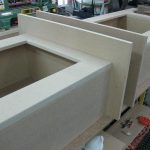We may receive a commission when you use our affiliate links. However, this does not impact our recommendations.
 I’ve been researching tall case clocks with an eye on building one for my home. but I’m troubled by the general lack of good proportioning in most if not all the design , the clocks have such large hoods, and small feet and bases in relationship to the body of the clock height. They appear ready to topple over; they don’t look “well grounded.” Is tall case clock design a rejection of the classic forms? The clocks vary so little in their proportions that the design must have seemed acceptable to the buyers of the time. What am I missing? Is my “eye” so skewed that i miss the point of tall case building or is the emperor without clothes? Thanks, M. Figueroa, Sacramento, Calif.
I’ve been researching tall case clocks with an eye on building one for my home. but I’m troubled by the general lack of good proportioning in most if not all the design , the clocks have such large hoods, and small feet and bases in relationship to the body of the clock height. They appear ready to topple over; they don’t look “well grounded.” Is tall case clock design a rejection of the classic forms? The clocks vary so little in their proportions that the design must have seemed acceptable to the buyers of the time. What am I missing? Is my “eye” so skewed that i miss the point of tall case building or is the emperor without clothes? Thanks, M. Figueroa, Sacramento, Calif.
Mr. Figueroa,
You are correct that compared to a building or a cabinet, the proportions on a tall case clock might appear on the surface to break many of the rules of good design. Actually just the opposite is true.
They are an example of designers addressing an application with some challenging functional requirements. Weight-driven pendulum movements found in these old cases required approximately 60″ of drop for the weights to power the gear train and chimes. The pendulum hangs off the bottom of the movement aprox 33″ and usually requires about 8″ of swing. In theory, you could just hang the movement on a high shelf, but air drafts and wandering kids and dogs tend to affect the accuracy of that type of arrangement.
Finally, the hood on top was somewhat dependent on
the physical size of the movement and the dial frames. It was thought to be quite an advantage to be able to clearly view a clock across a busy tavern full of boisterous revelers. Those functional requirements drive much of what we see in the overall design. My own guess as to why the waist section (middle) is narrower is due to a strong view at that time that a good design must have a beginning, middle, and ending.
These old cases follow that by starting with a square or a 4:5 rectangle at the base for a beginning, the slender waist for a middle, and finally the hood comprises the ending. Later in the 19th century, clockmakers began making cases much broader, sometimes to accommodate elaborate decorative pendulums. For my taste, I prefer the proportions in the earlier work.
For reference you might pick up a copy of “Painted Dial Clocks” By Brian Loomes. He gives a fair picture of the evolution of cases from 1770 to 1870.
George Walker,
Design Matters columnist
Here are some supplies and tools we find essential in our everyday work around the shop. We may receive a commission from sales referred by our links; however, we have carefully selected these products for their usefulness and quality.








